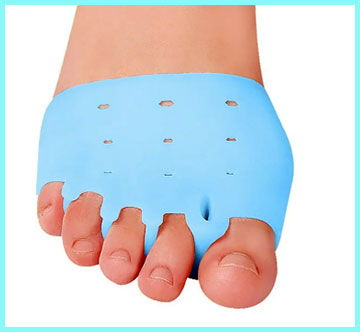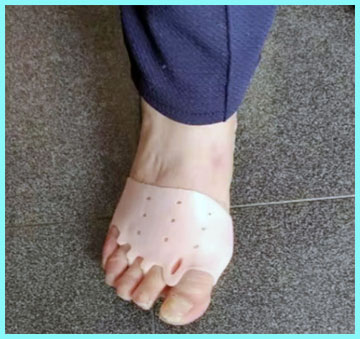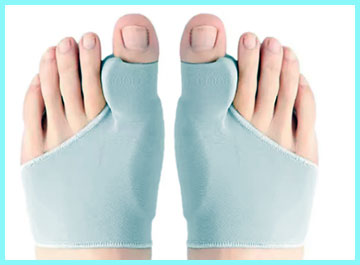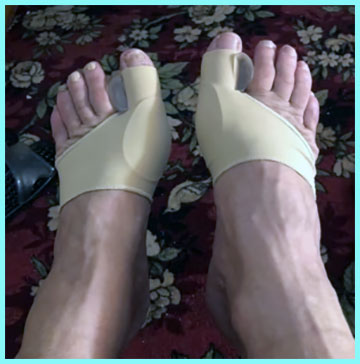We’re all here for the same reason, aren’t we? That angry, red, painful bump at the base of the big toe. That “bunion” that makes every shoe an instrument of torture and every step a calculation of pain. You’re searching for relief.
You’re searching for anything that isn’t surgery. And in that search, you’ve probably seen the Hyggear Bunion Corrector. It looks medical, it looks high-tech, and it’s cheap. My main intent here is to save you the money, the time, and the false hope. If you’re in real pain, you should not buy this product. This is my story.
My Experience With Hyggear Bunion Corrector
My bunion and I have been in a painful, long-term relationship. It’s a lovely parting gift from genetics and a few too many years in “fashionable” shoes. I’m at the point where I’ll try just about anything to avoid a conversation with a surgeon. So, when I saw the Hyggear Bunion Corrector kit online, I felt a surge of hope.

It wasn’t just one corrector; it was a whole “kit.”
It had the main, hinged, blue-and-white splint that looked like a piece of medical equipment, plus a bag full of gel spacers, toe separators, and a little strap.
It looked like a comprehensive, “all-in-one” solution. And the price? It was a fraction of what a single, high-end splint would cost.
I clicked “buy” immediately.
The optimism faded the second I opened the box.
The first red flag was the feel. The “medical-grade” plastic of the main splint felt lightweight, brittle, and hollow, like a cheap toy. The “soft foam” padding on the inside was a paper-thin piece of felt that seemed like it would disintegrate after one use. The velcro straps were stiff and had that “flimsy” feel where you know the stitching is going to give.
But, I was still hopeful. That night, I sat down to put it on. The instructions were a single, tiny, poorly-translated slip of paper. It was a confusing puzzle of “Strap A” and “Slot B.” After 10 minutes, I finally got it assembled on my foot.
The discomfort was immediate. The “one-size-fits-all” design is, in reality, a “one-size-fits-nobody.” To get it tight enough to supposedly pull my toe, the plastic hinge dug sharply into the side of my foot. The “comfort” pad was useless. I tried loosening it, but then it was just a loose piece of plastic flapping around. There was no “sweet spot.”
I decided to trust the process. “It’s a corrector,” I told myself, “it’s supposed to feel like something is happening.” I went to bed.
I woke up at 3 AM in more pain than I had ever felt from the bunion itself. The splint had shifted, and the velcro strap was now cinched down on the soft part of my arch, while the hinge was leveraging my big toe at a new, agonizing angle. I tore it off my foot and threw it across the room.
But I’m a glutton for punishment. I thought, “Okay, maybe it’s just a night splint. Let’s try the gel spacers for the day.” I put the little gel separator between my toes and slipped on my (wide-toe-box) sneaker. It felt okay for about 10 steps. Then, the gel, which was a very soft, “gummy” material, started to squish and roll, bunching up under my toes. By the time I got to my car, I had to take my shoe off and fish it out. It was a sticky, useless mess.
The final straw for the main splint came on night three. I, in my infinite wisdom, had decided to give it one last try, this time not as tight. The velcro strap, which I had only adjusted maybe five or six times, stopped sticking. The “loop” part of the “hook-and-loop” was already so fluffy and worn that it had zero grip.
This entire “kit” was in my trash can less than 72 hours after it arrived. My bunion was angrier, my skin was chafed, and I was out $25. It wasn’t a “corrector”; it was a “frustration-generator.”
Read More: My Thoughts On Kizu Spine Posture Corrector
Pros Of Hyggear Bunion Corrector
This is, without a doubt, the hardest part of this review. My experience was so negative that listing “pros” feels dishonest. However, for the sake of a balanced analysis, let’s look at the theoretical pros. These are the marketing claims and perceived advantages that get you to buy the product, even if they don’t hold up in reality. This is what the product claims to be.
- The Concept of a Hinged Splint: The biggest “pro” is the design concept. A rigid splint locks your foot in one position, making it a “night-only” device. A hinged splint, in theory, is supposed to be the holy grail. The hinge is meant to align with your MTP (metatarsophalangeal) joint, allowing your foot to flex and bend while you walk. This should mean you could wear it around the house, providing gentle, active correction all day. The idea is brilliant. The execution in this product, however, completely fails to deliver on this promise, as the hinge is stiff, misaligned, and poorly constructed.
- An All-in-One, High-Value Appearance: When you look at the product listing, you’re not just buying one splint. You’re getting a 7, 10, or even 15-piece “kit.” It’s packed with a variety of gel toe spacers, a bunion “sleeve,” a stretchy toe-exercise band, and the main hinged splint. This looks like an incredible bargain. You feel like you’re getting a complete, holistic bunion-management system for the price of a single pizza. This perceived value is a huge “pro” in getting you to make the purchase, even if you find (as I did) that every single one of those 15 pieces is made from the cheapest, least-durable materials possible.
- The Low, Accessible Price Point: Let’s be blunt: this is the main reason we’re all here. It’s cheap. When you’re in chronic pain, and you see a potential solution for under $30, it’s an “impulse-buy” level of accessible. A single, high-quality, German-engineered splint (which this product is a knock-off of) can cost upwards of $70. The low price of the Hyggear makes it a very low-risk financial investment, which is a “pro” for your wallet, even if it ends up being a high-risk investment for your foot’s comfort.
- The Promise of a Non-Surgical Solution: This is the core psychological “pro.” This product, and all products like it, sell hope. They sell the idea that you can avoid a painful, expensive, and recovery-intensive surgery by simply wearing a device. It’s marketed as a “corrector,” which implies it can reverse your bunion. While we will discuss in the FAQ that this is medically impossible, the hope of correction is the product’s main selling point. It’s a powerful motivator that makes the other cons (like the cheap feel) seem ignorable at first.
- Wide Availability and Ease of Purchase: You don’t have to go to a specialist. You don’t need a prescription. You can find this, or a dozen identical knock-offs, on every major online marketplace with a single click. This “pro” is one of convenience. It’s the “fast-food” of bunion care—readily available, cheap, and ultimately, not very good for you.
Cons Of Hyggear Bunion Corrector

This is the part that needs the most attention. My experience was not a one-off. The negative reviews that litter the internet for this product all point to the same, critical, and frankly, dangerous, flaws.
What To Know Before You Buy
- Crippling, Catastrophic Durability Issues:
- The Velcro is the First to Die: This is the most-reported complaint, and it’s what happened to me. The velcro (the “hook-and-loop”) is of the absolute lowest quality. The “loop” side (the soft, fluffy part) gets matted and worn down, and the “hook” side gets clogged with lint. After 2-3 nights of adjusting it, it simply stops gripping. A corrector that cannot stay on your foot is not a corrector; it’s just plastic garbage.
- The Straps Themselves Are Weak: The straps are made of a thin, non-elastic material with a flimsy piece of foam glued to them. The stitching that holds the velcro pad to the strap is often the next point of failure. A single, firm pull (which you need to do to get any “correction”) is often enough to tear the stitching.
- The “Unbreakable” Hinge… Breaks: The marketing loves to show the hinge. But it’s made of a brittle, non-flexible plastic. Users report that it simply snaps when they try to walk in it, or that the pin holding the hinge together just falls out. It’s not built to withstand any real-world torque or body weight.
- A “One-Size-Fits-Nobody” Design Fiasco:
- The Fit is a Nightmare: This is the product’s most dangerous flaw. It is advertised as “one-size-fits-all.” On my foot (a women’s size 8), it was bulky and awkward. Reviews from people with smaller feet say it’s impossible to secure. Reviews from people with larger feet (or more severe bunions) say it’s agonizingly tight and the plastic cuts into them.
- The Hinge is Misaligned: The hinge is supposed to align with your joint. But since all feet are different, this cheap, fixed-position hinge never aligns properly. The result is that the splint isn’t pulling your toe straight… it’s pulling it up or down, creating a new, painful “jamming” force on the joint.
- There is No “Comfort” Padding: That little piece of blue or white felt they call “padding” is a joke. It’s paper-thin and does nothing to cushion your already-inflamed, painful bunion from the hard, unforgiving plastic. The splint itself becomes the new source of pain.
- It Can Genuinely Make Your Pain Worse:
- Chafing, Blisters, and Cuts: Because the materials are cheap, the edges of the plastic are often sharp. They were not sanded, beveled, or finished. These sharp edges dig into your skin. The rough straps rub against your foot. This leads to chafing, blisters, and in some reviews, actual cuts.
- Incorrect, Painful Alignment: As I experienced, a splint that shifts in the night is terrifying. Because the velcro is so poor, it will loosen, slip, and then snag on your sheets, twisting your foot into a new, unnatural position. This can cause acute pain in your toe, your arch, and even your ankle, as your body tries to compensate.
- The “Bonus” Kit is Just as Bad:
- The Gel Spacers are Useless: The included gel pieces are made from a very soft, “gummy” silicone (TPE), not the firm, medical-grade silicone of high-quality brands. They are “sticky,” so they attract every piece of lint and hair, and they squish and deform inside your shoe, turning into a bunched-up, uncomfortable “wad.”
- The “Exercise Strap” Snaps: The little blue strap for “strengthening” your toe is a thin, flimsy rubber band that provides almost no real resistance and is known to snap after a few uses.
Maintenance Tips For Bunion Care (Since This Product Won’t Help)

My first and most important “maintenance tip” for the Hyggear Bunion Corrector is to throw it in the trash. Please do not waste your time trying to “fix” it, add new velcro, or “whittle” the sharp plastic. You cannot “maintain” a fundamentally broken product.
Instead, let’s refocus. If you are in pain from a bunion, this is the “maintenance” you should be doing. These are the real, podiatrist-approved tips that will actually help you manage your symptoms and slow the progression.
- Tip 1: Your New Religion is “Footwear, Footwear, Footwear”:
- This is the only “corrector” that truly matters. You cannot “fix” a bunion with a splint while simultaneously jamming your foot into a narrow, pointy, “fashionable” shoe.
- The “Wide-Toe-Box” Mandate: You must get shoes that are foot-shaped. This means a “wide-toe-box,” which is not the same as a “wide” shoe. A wide-toe-box is anatomical, allowing your toes to splay out naturally. Brands like Altra, Topo Athletic, and Lems are your new best friends.
- The “Zero-Drop” Goal: A “zero-drop” shoe means your heel is at the same level as your forefoot (no raised heel). High heels are the worst offenders, as they force all your body weight directly onto the bunion joint. But most “normal” sneakers have a 10-12mm heel drop, which still creates unnatural pressure. Weaning yourself down to a zero-drop shoe will change your life.
- The “At-Home” Rule: Never walk barefoot on hard floors. This puts immense stress on your joints. Get a pair of supportive, wide-toe-box house shoes (like Oofos or Crocs) and wear them religiously.
- Tip 2: Your Bunion is a Symptom; Your Foot is the Patient:
- Focus on Foot Strength: Your bunion is often a sign of a collapsed arch and weak intrinsic foot muscles. A splint is a “passive” crutch. You need “active” strengthening.
- The “Big Toe” Lifts: Sit with your foot flat. Try to lift only your big toe, while keeping the other four toes flat on the ground. Then, reverse it: lift the four toes while keeping the big toe down. This is hard, and it’s a sign your brain-foot connection is weak. Do it 10-15 times.
- “Toe-Yoga” / Toe Spreading: While sitting, actively splay your toes as wide apart as you can. Hold for 5 seconds, then relax.
- The “Short-Foot” Exercise: This is the best exercise. Sit with your foot flat. Without curling your toes, try to “shorten” your foot by pulling the ball of your foot back towards your heel. You should feel your arch engage. This builds your main arch-support muscle.
- Tip 3: How to Actually Use Spacers and Taping:
- Ditch the “Gummy” Spacers: The cheap gel in the Hyggear kit is useless. You need medical-grade silicone. The best ones are Correct Toes. They are expensive, but they are designed by a podiatrist, are durable, and will last for years. They are the “Hyggear” you thought you were buying.
- Kinesiology Tape is Your Friend: You can learn to tape your foot to provide the same gentle “pull” as a splint, but in a way that is flexible and can be worn 24/7. Look up “bunion taping” on YouTube. It’s a game-changer. It supports the arch and gently pulls the toe, all without any bulky, painful plastic.
- Tip 4: Maintenance for a High-Quality Splint (If You Buy One):
- If you ignore my advice and buy a real, expensive splint (like a BunionAid or a rigid post-op splint), this is how you care for it.
- Hand-Wash, Air-Dry: The straps and pads are the main thing. Never put them in a dryer. The heat will destroy the velcro and melt the foam. Hand-wash them with a bit of gentle soap, rinse, and let them air-dry.
- Clean the Hinge/Plastic: Wipe the plastic parts down with a damp cloth or an alcohol wipe to keep them free of skin oils and bacteria.
- Inspect for Cracks: Because these are meant to bear some load, you must check the hinge and plastic for any hairline-fractures before you put it on, especially if it’s a night splint. A splint that breaks while you’re sleeping is a serious hazard.
Comparison With Other Brands

The Hyggear isn’t just one product; it’s a category of product. It’s the cheap, mass-produced, blue-and-white knock-off. Let’s compare it to the other types of bunion management.
- Hyggear vs. Rigid Night Splints:
- The Concept: A rigid night splint is not hinged. It’s a solid piece of plastic that holds your toe in a fixed, straight position. It is only for sleeping.
- The Reality: These are often more effective at providing temporary, morning pain-relief because they are unambitious. They don’t pretend you can walk in them. By being rigid, they provide a more consistent, static stretch.
- My Verdict: A simple, rigid night-splint (even a cheap one) is often a better purchase than the Hyggear, because its simple design is harder to “get wrong,” and it doesn’t promise a “walkable” feature it can’t deliver.
- Hyggear vs. BunionAid (and other “Premium” Hinged Splints):
- The Concept: BunionAid is a German-engineered splint. It looks a lot like the Hyggear. This is because the Hyggear is a direct knock-off of this design.
- The Reality: The BunionAid uses high-grade, durable plastics, a real metal-pin hinge, and properly-designed, long-lasting straps. It actually flexes with your foot. It also costs 3-4 times as much.
- My Verdict: This is a classic “you get what you pay for” scenario. The Hyggear proves that the concept is a failure… unless it’s made with high-quality materials. If you are set on a hinged splint, save your money and buy the real one. The Hyggear is a “toy” version.
- Hyggear vs. “Correct Toes” (and other high-end spacers):
- The Concept: Correct Toes are medical-grade silicone spacers, designed by a podiatrist, to be worn while active (walking, running) inside wide-toe-box shoes.
- The Reality: This is, in my opinion, the most effective non-surgical treatment. A spacer doesn’t look as impressive as a “splint,” but it’s far more practical. It “corrects” your toe position while you are using your foot, retraining the muscles and providing relief all day.
- My Verdict: I would take a single pair of $60 Correct Toes over 100 free Hyggear kits. The Hyggear is a passive, bulky, painful crutch. Correct Toes are an active, comfortable, effective tool.
- Hyggear vs. Kinesiology Tape:
- The Concept: A $15 roll of athletic tape. By applying it strategically, you can create a “splint” that is part of your skin.
- The Reality: It’s incredibly effective. It provides support, relieves pain, and is invisible inside your shoe. It has a learning curve, and you’ll waste a lot of tape at first, but once you “get it,” it’s a game-changer.
- My Verdict: A roll of tape is a far better investment. It’s more comfortable, more effective, and won’t break.
Also Read: Comparison Of Hyperice Venom 2 And Therabody
Frequently Asked Questions (FAQ)
This is the million-dollar question. In my opinion, the best corrector isn’t a single product. It’s a system that you create: (1) Wide-toe-box shoes, (2) High-quality silicone spacers (like Correct Toes), and (3) Intrinsic foot-strengthening exercises. If you’re looking for a splint, I would avoid cheap, plastic ones like the Hyggear and look at simple, rigid night-splints or kinesiology tape.
This is a very important question. Podiatrists do not recommend devices that claim to “correct” a bunion, because they know this is medically impossible. They will never recommend a cheap, low-quality device like the Hyggear that can cause pain and blisters. However, a podiatrist may recommend a high-quality rigid splint for post-operative recovery, or simple spacers and taping to manage symptoms (pain and inflammation) and slow progression.
You cannot “correct” a bunion without surgery. A bunion (hallux valgus) is a change in your bone structure. The bones have “drifted.” No splint, spacer, or exercise can reverse that bone change. Surgery is the only way to “correct” the bunion. What you can do without surgery is manage the symptoms (the pain, inflammation, and redness) and slow the progression so it doesn’t get worse.
They do not “work” to correct or reverse a bunion. Let’s be perfectly clear on that. A high-quality splint or spacer can “work” to provide temporary pain relief, reduce inflammation, and gently stretch the surrounding soft tissues. A low-quality product like the Hyggear, in my experience, does not “work” at all. It breaks, it fits poorly, and it can make the pain worse.
Conclusion
I know you’re in pain, and I know you were hoping this was the answer. My experience, and the experience of thousands of others in online reviews, shows that the Hyggear Bunion Corrector is not the solution you’re looking for. It’s a masterclass in false hope—a product that looks medical but is built like a toy. It’s a waste of money, a source of frustration, and a potential “pain-creator.” My final advice? Save your $25. Put it towards a good pair of shoes or a consultation with a real podiatrist. Your feet will thank you.
